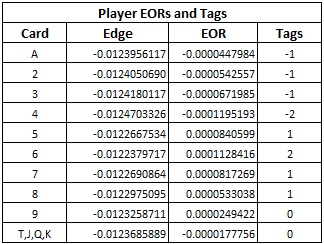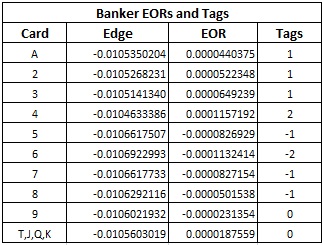Baccarat Card Counting: Update #1

By Anonymous
|
|
Baccarat card counting is a hopeless endeavor. That doesn't mean that I can't develop better card counting systems or run more accurate simulations than I have in the past. This post improves upon earlier results I first presented in December, 2011 (see this post). Card counting gives a linear approximation to the actual edge at any point in the shoe, based on the true count. As such, no card counting system can do better than computer-perfect play. As I showed in this post, the win rates for computer-perfect play in baccarat are:
The following table shows the effect of removals for the various cards in baccarat for the Player bet as well as a reasonable level-2 card counting system based on these EORs:
The recommended card counting system is: (-1, -1, -1, -2, 1, 2, 1, 1, 0, 0). This system has a betting correlation of 0.969, which is fairly good (1.00 is perfect correlation).
Here are the results of a simulation of one billion (1,000,000,000) shoes of baccarat with the cut card at 14 cards, using the card counting system given above:
If a player makes a $1000 Player wager whenever the true count is 22 or higher, and otherwise doesn't make a Player wager, then he will make approximately one wager every eleven shoes (16.5 hours) and his win rate will be about 50.3 cents per 100 hands. (Computer-perfect play gives a win rate of about 95 cents per 100 hands).
I note that Ed Thorp advocated using the card counting system (-1, -1, -2, -2, 1, 2, 2, 1, 0, 0) to count the Player bet. This system is slightly weaker than the system given above, with betting correlation 0.953. In my original post on baccarat card counting, this is the system I investigated.
Card counting the Banker bet
The following table shows the effect of removals for the various cards in baccarat for the Banker bet as well as a reasonable level-2 card counting system based on these EORs:
The recommended card counting system is: (1, 1, 1, 2, -1, -2, -1, -1, 0, 0). This system has a betting correlation of 0.967, which is also fairly good. Here are the results of a simulation of one billion (1,000,000,000) shoes of baccarat with the cut card at 14 cards, using the card counting system given above:
I note that computer-perfect play against the Banker bet gives a win rate of 0.00076 units per 100 hands.
If a player makes a $1000 Banker wager whenever the true count is 25 or higher, and otherwise doesn't make a Banker wager, then he will make approximately one wager every twenty-two shoes (36 hours) and his win rate will be about 12.5 cents per 100 hands. (Computer-perfect play gives a win rate of about 76 cents per 100 hands).
Note that the card counting system for Banker is simply the "negative" of the Player system, so it is possible to use the Player system for both the Banker and Player wagers. Make a Player bet if the true count is 22 or higher and a Banker bet if the true count is -25 or lower. By using this system, and making a $1000 wager on the appropriate wager whenever the count indicates, the professional baccarat card counter can earn approximately 63 cents per 100 hands. Given that the game pace for baccarat is about 50 hands per hour (maybe slower), the win rate is about 31.5 cents per hour. In an eight-hour day, the $1000 baccarat card counter will earn about $2.50 per day, the price of a cup of coffee.
With $1000 wagers, computer-perfect play in baccarat has a win rate of $1.71 per 100 hands; card counting has a win rate of 63 cents per 100 hands.
- 0.00076 units per 100 hands against the Banker bet.
- 0.00095 units per 100 hands against the Player bet.
- 0.00171 units per 100 hands combined Banker/Player bets.
- If the player makes a $1000 wager whenever he has the edge and otherwise does not make a wager, then the player will win, on average, about $1.71 per 100 hands.
The following table shows the effect of removals for the various cards in baccarat for the Player bet as well as a reasonable level-2 card counting system based on these EORs:

The recommended card counting system is: (-1, -1, -1, -2, 1, 2, 1, 1, 0, 0). This system has a betting correlation of 0.969, which is fairly good (1.00 is perfect correlation).
Here are the results of a simulation of one billion (1,000,000,000) shoes of baccarat with the cut card at 14 cards, using the card counting system given above:
- System: (-1, -1, -1, -2, 1, 2, 1, 1, 0, 0).
- Target true count: 22.
- Bet frequency: 0.1139% (1-in-878 hands).
- Average edge: 0.4413%.
- Units won per 100 hands: 0.000503.
If a player makes a $1000 Player wager whenever the true count is 22 or higher, and otherwise doesn't make a Player wager, then he will make approximately one wager every eleven shoes (16.5 hours) and his win rate will be about 50.3 cents per 100 hands. (Computer-perfect play gives a win rate of about 95 cents per 100 hands).
I note that Ed Thorp advocated using the card counting system (-1, -1, -2, -2, 1, 2, 2, 1, 0, 0) to count the Player bet. This system is slightly weaker than the system given above, with betting correlation 0.953. In my original post on baccarat card counting, this is the system I investigated.
Card counting the Banker bet
The following table shows the effect of removals for the various cards in baccarat for the Banker bet as well as a reasonable level-2 card counting system based on these EORs:

The recommended card counting system is: (1, 1, 1, 2, -1, -2, -1, -1, 0, 0). This system has a betting correlation of 0.967, which is also fairly good. Here are the results of a simulation of one billion (1,000,000,000) shoes of baccarat with the cut card at 14 cards, using the card counting system given above:
- System: (1, 1, 1, 2, -1, -2, -1, -1, 0, 0).
- Target true count: 25.
- Bet frequency: 0.0556% (1-in-1798 hands).
- Average edge: 0.2242%.
- Units won per 100 hands: 0.000125.
I note that computer-perfect play against the Banker bet gives a win rate of 0.00076 units per 100 hands.
If a player makes a $1000 Banker wager whenever the true count is 25 or higher, and otherwise doesn't make a Banker wager, then he will make approximately one wager every twenty-two shoes (36 hours) and his win rate will be about 12.5 cents per 100 hands. (Computer-perfect play gives a win rate of about 76 cents per 100 hands).
Note that the card counting system for Banker is simply the "negative" of the Player system, so it is possible to use the Player system for both the Banker and Player wagers. Make a Player bet if the true count is 22 or higher and a Banker bet if the true count is -25 or lower. By using this system, and making a $1000 wager on the appropriate wager whenever the count indicates, the professional baccarat card counter can earn approximately 63 cents per 100 hands. Given that the game pace for baccarat is about 50 hands per hour (maybe slower), the win rate is about 31.5 cents per hour. In an eight-hour day, the $1000 baccarat card counter will earn about $2.50 per day, the price of a cup of coffee.
With $1000 wagers, computer-perfect play in baccarat has a win rate of $1.71 per 100 hands; card counting has a win rate of 63 cents per 100 hands.
Go get 'em, cowboy!


